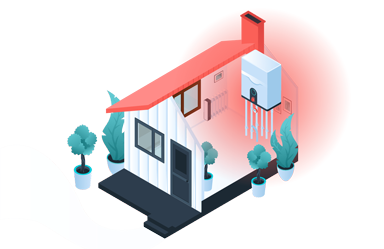How To Fix Your Frozen Boiler Condensate Pipe + Prevention Tips
Throughout this site, we’ve covered a tonne of different boiler problems. But, if you’ve got a broken boiler and it’s below freezing outside, it’s most likely to be one thing; a frozen condensate pipe.
And, most Gas Safe engineers are ridiculously busy this time of year (mainly, for this reason).
So what can you do?
This guide covers:
- Error Codes That Relate To A Frozen Condensate Pipe
- How To Fix Your Frozen Boiler
- Preventing Your Condensate Pipe From Freezing In The Future.
Error Codes
There’s a quick way to determine if your frozen boiler’s problem, is due to a condensate pipe issue.
When your boiler develops a problem, it will lockout. After the lockout, a fault code should be shown on the display panel. Below, we’ve listed some that are likely to be connected to this issue.
Please be advised, this is not an exhaustive list. Search your fault code online. If it relates to a condensate problem, ignition fault or airway blockage, it’s likely a frozen condensate pipe is to blame.
| Brand | Fault Code |
| Baxi | E133 or E28 |
| Ideal Boilers | L2, LF or F2 |
| Glow-Worm | F28 or F29 |
| Potterton | E133 or E28. Or, the error code may alternate between E1 and E33 |
| Worcester Bosch | EA229 or D5 |
| Vaillant | F28 or F29 |
| Viessmann | F4 |
Fixing Your Frozen Boiler
If you’re still unsure of what to do and how to locate your condensate pipe after the 3 steps, check out this video from Worcester Bosch:
To fix your frozen boiler, you need to thaw your external condensate pipe. But before doing that, you need to locate it. Depending on how and when your boiler was installed, this pipe could be 21.5mm-32mm in diameter.
- Locate your condensate pipe, it should be extremely close to an external drain.
- Thaw the condensate pipe using warm water (boiling water is likely to crack the condensate pipe).
- Reset your boiler to clear the fault code on the display panel.
Protecting Your Condensate Pipe From Freezing
Now you’ve got your boiler up and running again, here’s what you can do to stop this problem from occurring again.
-
Upgrade Your Condensate Pipe To 32mm
As we mentioned above, some installations may have a 21.5mm external condensate pipe, when it should be bigger. And, this should be where you start.
Upgrading your condensate pipe to a larger diameter pipe, will reduce the risk of it freezing.
-
Route It As Close To Horizontal As Possible
You should use a Gas Safe installer to help you upgrade your external condensate pipe.
When doing so, they’ll route the pipe as close to vertical as possible. Condensed gases freeze easily, so the quicker they can escape, the less chance you have of them freezing.
-
Lag Your Condensate Pipe
All plumbing merchants carry a range of lagging. This is designed to protect pipes from wintry conditions.
So, when your boiler engineer is upgrading your condensate pipe, ask them to lag the pipes to stop them from freezing in the future.
-
Install A Condense-Sure Syphon
Worcester Bosch have released their new Condense-Sure Syphon, designed to prevent this exact scenario.
Instead of condensed gases continuously dripping from the condensate pipe, up to 0.5L is stored in the syphon.
When the condensed gases are eventually released, not only is this at a higher volume, it’s also going to be at a higher temperature, reducing the risk of freezing.
There are details on the Condense-Sure Syphon from Worcester Bosch, at 2m34s in the above video.
What’s Next?
Still got questions about your broken boiler?
Use our contact form to get in touch and we’ll do our best to help you out.
